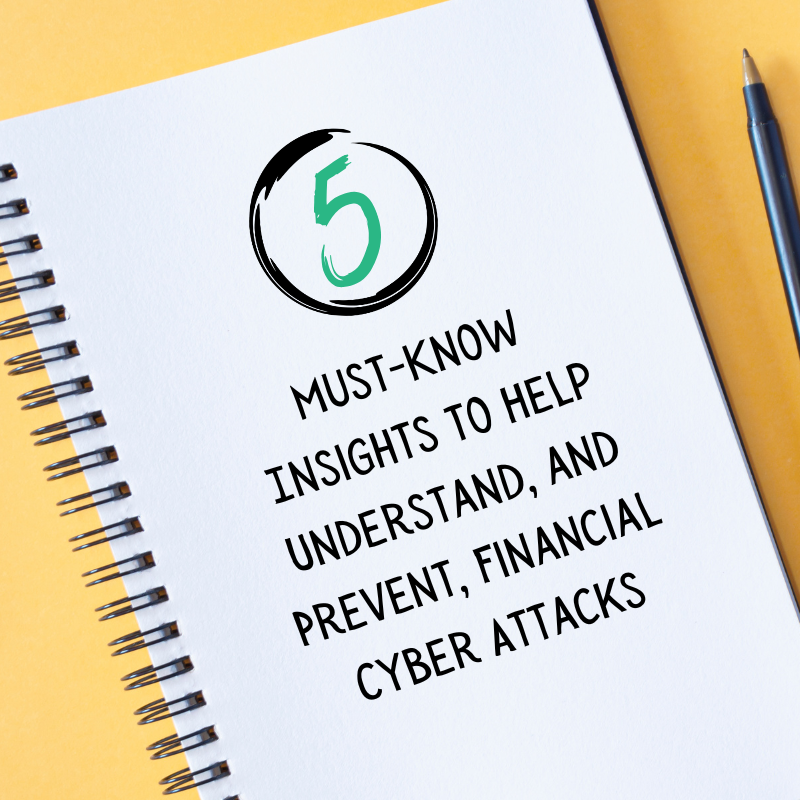5 Must-Know Insights to Help Understand, and Prevent, Financial Cyber Attacks

Cyber threats are evolving at an unprecedented pace, and financial institutions remain prime targets for attackers looking to exploit sensitive data and critical systems. As cybercriminals become more sophisticated—leveraging AI-powered phishing scams, ransomware attacks, and insider threats—traditional security measures are struggling to keep up. It’s no longer enough to rely on reactive defenses that detect and respond after a breach has already occurred. Instead, financial institutions must adopt proactive security to prevent threats before they infiltrate their systems.
This was the central theme of a webinar at SecureWorld’s 2025 Virtual Financial Services Security Summit. The webinar, Preventing Emerging Threats in Financial Services with Proactive Data Security, featured cybersecurity expert and Chief Product Officer at Votiro, Eric Avigdor, as they explored the most pressing risks facing the financial sector today.
During the webinar, Avigdor detailed how attackers bypass legacy security tools and why institutions need to rethink their approach to data protection. Most importantly, he shared five key takeaways that financial organizations should take note of in order to stay ahead of emerging threats.
In this article, we break down Avigdor’s takeaways and what they mean for financial cybersecurity.
1. Financial Institutions Face Three Major Cyber Threats
Financial institutions are prime targets for cybercriminals due to the sheer volume of sensitive data they handle and the high-stakes nature of financial transactions. Attackers constantly refine their methods, exploiting weaknesses in systems, employees, and third-party vendors. The three most pressing cyber threats facing financial services today are malware & ransomware attacks, insider threats, and third-party risk—each capable of causing devastating breaches.
Take, for example, the Evolve Bank breach, where a simple phishing email led to malware infiltration, compromising customer data. Similarly, the Toronto Dominion Bank incident revealed how insiders—whether malicious or careless—can misuse privileged access to leak sensitive information. Beyond internal risks, financial institutions must also contend with third-party vulnerabilities, as seen in the Truist Bank breach, where an external contractor’s security failure exposed critical customer data.
2. AI is Supercharging Cyber Threats
Artificial intelligence has revolutionized cybersecurity—but not just for defenders. Attackers are now using AI to supercharge their tactics, making cyber threats more deceptive, scalable, and effective than ever before. AI-powered phishing attacks are no longer riddled with grammatical errors or awkward phrasing; they are highly personalized, context-aware, and nearly indistinguishable from legitimate communications. This makes them significantly harder to detect and far more successful in deceiving even the most cautious employees.
What’s even more concerning is that AI has lowered the barrier to entry for cybercrime. Previously, sophisticated attacks required deep technical expertise. Still, even low-skill attackers can now use AI tools to craft convincing phishing emails, generate deep fake scams, or automate credential-stuffing attacks at an unprecedented scale and rate of reproduction.
3. Legacy Security Tools Are No Longer Enough
Financial institutions have relied on legacy security tools like Data Loss Prevention (DLP) and Data Security Posture Management (DSPM) to safeguard sensitive data for years. However, as cyber threats become more advanced and business operations shift toward cloud-based environments, these traditional solutions are proving insufficient—often creating more challenges than they solve.
DLP, once a cornerstone of data security, now struggles with accuracy. Its reliance on rigid rule-based enforcement leads to excessive false positives, causing frustration among employees and overwhelming security teams. In many cases, organizations disable enforcement altogether to avoid workflow disruptions, leaving critical data exposed. Worse yet, DLP was designed for endpoint protection, not for the modern SaaS and cloud-based ecosystem, where sensitive data moves fluidly across applications, APIs, and collaboration tools.
Similarly, DSPM provides visibility into data storage and access permissions but lacks real-time prevention capabilities. While knowing where risks exist is valuable, visibility alone does not stop data breaches from occurring.
4. DDR—the Future of Proactive Security
As cyber threats become more sophisticated, financial institutions need a proactive security strategy that stops attacks before infiltrating critical systems. Data Detection & Response (DDR) is emerging as the next evolution in cybersecurity, offering real-time prevention instead of relying on reactive cleanup efforts. Unlike legacy tools that detect and respond after a breach, advanced DDR platforms are able to neutralize threats before they cause damage.
At the core of Votiro’s own DDR platform is advanced Content Disarm and Reconstruction (CDR), a technology that removes malware and ransomware from files before they ever reach the network, while still enabling full file functionality. This eliminates zero-day threats and prevents malicious payloads from exploiting vulnerabilities without compromising on productivity. Additionally, Votiro’s AI-trained, active data masking ensures that sensitive information (such as PII and PCI) is only accessible to authorized users, significantly reducing the risk of insider threats and accidental data leaks.
Perhaps most importantly, sophisticated DDR solutions enable automated enforcement to prevent data exfiltration in real time, removing the need for constant manual oversight. By addressing the security gaps left by DLP and DSPM, DDR allows financial institutions to move beyond reactive security measures and embrace a truly preventative approach that keeps threats out rather than cleaning up after a breach.
5. Unstructured Data is the Biggest Security Blind Spot
Financial institutions handle vast amounts of sensitive data, but many fail to recognize that 80% of this data is unstructured—flowing unpredictably across emails, cloud storage, collaboration platforms, and APIs. Unlike structured data, which is neatly contained within databases and governed by strict access controls, unstructured data moves fluidly, often without security teams even realizing it. This creates an enormous attack surface that traditional security tools are not designed to protect.
Files containing sensitive customer information can be inadvertently shared in an email, uploaded to a third-party cloud service, or accessed through collaboration tools like Slack or Teams. These interactions can lead to data leaks, insider threats, and regulatory compliance violations without real-time security enforcement. Again, this is where a solution like Votiro DDR eases the workload for overburdened IT teams and helps enterprises remain compliant.
It’s Time to Take Action
From understanding the biggest cyber risks in the industry to adopting next-generation solutions like Data Detection & Response, this webinar underscored the urgent need for a shift in security strategy.
Protecting data in motion—whether shared internally, externally, or across cloud-based platforms—requires proactive threat and exposure prevention, not just visibility. Votiro’s DDR is the key to stopping threats before they infiltrate, preventing malware ingestion, data exfiltration, and unauthorized access without disrupting business operations.
Schedule a demo with Votiro to see how proactive, real-time security can eliminate threats before they become breaches.
News you can use
Stay up-to-date on the latest industry news and get all the insights you need to navigate the cybersecurity world like a pro. It's as easy as using that form to the right. No catch. Just click, fill, subscribe, and sit back as the information comes to you.
Sign-up Here!
Subscribe to our newsletter for real-time insights about the cybersecurity industry.



